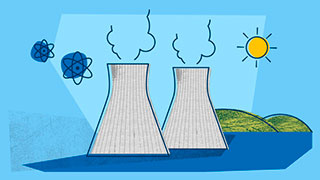




Over 300 industry leaders, policymakers, and technical experts met in Montreal, Canada for World Nuclear Fuel Cycle (WNFC) 2025 conference, held from April 8–10. They explored the evolving dynamics of the global nuclear fuel market, including uranium mining, conversion and enrichment. Co-organized by World Nuclear Association and the Nuclear Energy Institute, the event focused on what the growing demand for secure, reliable, 24/7 clean energy will mean for the nuclear fuel cycle.
We thank Cameco and Orano our two sponsors, for the event, as well as Cameco and Quebec Hydro for facilitating technical tours to Port Hope Conversion Facility & Cameco Fuel Manufacturing, and Gentilly-2 Nuclear Reactor, respectively.
Discussions highlighted the significant global investment required for new uranium exploration and mining, as well as for the upscaling of all our nuclear fuel services capabilities, within the context of changing market dynamics, increasing energy security concerns, and the need to deliver advanced fuels to meet new reactor technologies.
"It all starts with the fuel cycle. Without the uranium, there is no nuclear,"
Tim Gitzel, CEO, Cameco
Strengthening the Nuclear Fuel Supply Chain
The International Energy Agency (IEA) projects that global nuclear energy generation will reach an all-time high in 2025, surpassing the previous record set in 2021. This growth is attributed to the commissioning of new reactors and increased interest from sectors requiring stable, low-emission energy sources. Moving forward, as countries, financiers and large energy users support the goal of tripling global nuclear capacity by 2050, the trend is expected to continue and intensify.
Therefore, a significant focus of the conference was on fortifying the nuclear fuel supply chain to meet the growing global demand for clean energy. John-Paul Jones, Head of Commercial Intelligence at Urenco, emphasized the need for collaboration, communication, and clarity among stakeholders to achieve decarbonization goals. He also highlighted Urenco's capacity programme, which includes refurbishing and potentially expanding enrichment capacity at its four sites, with the first additional capacity expected online in 2025.
“As long as we collaborate, we will deliver.”
John-Paul Jones, Head of Commercial Intelligence, Urenco
Transport is an essential service – and was put in the spotlight during the conference. As well as a capacity gap, our expert panel highlighted issues related to marine transportation including: nuclear liability concerns; stowage limitations; port acceptance issues; and political and regulatory challenges.
"The industry is expanding, but the shipping capacity is not."
George Kargopolov, CIS Navigation
Addressing Geopolitical Challenges
The conference also addressed the impact of geopolitical tensions on the nuclear fuel market and logistics. The nuclear fuel market has benefited for many years of a global outlook, which has changed in recent times. Some utilities, countries and regions have diversified supplies as a result. The development of additional capabilities such as restarting uranium conversion at the Springfields site in the UK, new mines in Uzbekistan, EU funding for French enrichment plant expansion, as well as technology development such as laser enrichment. Tim Gitzel, CEO of Cameco, pointed to a changing narrative that has gone from an emphasis on energy security to national security, and now - for the USA, at least - energy dominance.
“There isn’t a technology anywhere that can be done in one country. We will always rely on other countries... There is always going to be these inter-connections... I think to be successful we as an industry have to step up above the politics and be global.”
Nicolle Butcher, President and CEO, Ontario Power Generation
Reflecting on World Nuclear Fuel Cycle
The fuel cycle is at a pivotal moment. Global nuclear energy is on the cusp of significant expansion and without fuel you can’t run a reactor. Significant financial investment will bring opportunities in exploration, mining, conversion, enrichment, and fabrication, all of which are needed to meet the anticipated increasing demand for nuclear energy going forward.
What’s next? The Association will publish its authoritative global uranium and nuclear fuel services market outlook, biennial World Nuclear Fuel Report in September. For the first time, this will include a new chapter providing more granular information about regional markets and how we are entering a situation where we can no longer assume there is unrestricted global free trade in nuclear fuel services. As in previous editions, the World Nuclear Fuel Report will assess potential future trade and nuclear fuel supplies, responding to the new market dynamics and interest from outside the traditional nuclear sector.
“The nuclear industry is at its most exciting moment in a long time, the opportunities are becoming clearer. We must continue to collaborate, working together to ensure every project is a success, then more projects and programmes will follow. The global nuclear industry succeeds when it is united.”
Sama Bilbao y León, Director General, World Nuclear Association
Источник:www.world-nuclear.org